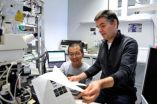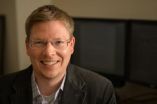(Press-News.org) In the world of quantum science, Alice and Bob have been talking to one another for years. Charlie joined the conversation a few years ago, but now with spacelike separation, scientists have measured that their communication occurs faster than the speed of light.
For the first time, physicists at the Institute for Quantum Computing (IQC) at the University of Waterloo have demonstrated the distribution of three entangled photons at three different locations (Alice, Bob and Charlie) several hundreds of metres apart, proving quantum nonlocality for more than two entangled photons.
The findings of the experiment, Experimental Three-Particle Quantum Nonlocality under Strict Locality Conditions, are published in Nature Photonics today.
Once described by Einstein as "spooky action at a distance", this three-photon entanglement leads to interesting possibilities for multi-party quantum communication.
Nonlocality describes the ability of particles to instantaneously know about each other's state, even when separated by large distances. In the quantum world, this means it might be possible to transfer information instantaneously – faster than the speed of light. This contravenes what Einstein called the "principle of local action," the rule that distant objects cannot have direct influence on one another, and that an object is directly influenced only by its immediate surroundings.
To truly test that the hidden local variables are not responsible for the correlation between the three photons, IQC scientists needed the experiment to close what is known as the locality loophole. They achieved this separation of the entangled photons in a way that did not allow for a signal to coordinate the behaviour of the photons, but beaming the entangled photons to trailers parked in fields several hundred meters from their lab.
"Correlations measured from quantum systems can tell us a lot about nature at the most fundamental level," said co-author Professor Kevin Resch, Canada Research Chair in Optical Quantum Technologies and recent winner of the E.W.R. Steacie Fellowship from the Natural Sciences and Engineering Research Council of Canada (NSERC). "Three-particle entanglement is more complex than that of pairs. We can exploit the complex behaviour to rule out certain descriptions of nature or as a resource for new quantum technologies."
The project team studied the correlations of three photons in a Greenberger-Horne-Zeilinger (GHZ) state – a type of entangled quantum state involving at least three particles.
First, photon triplets were generated in Resch's lab – the Alice in the experiment. Then, the first photon was delayed in a 580m optical fibre in the lab while the two other photons travelled up 85m of optical fibre to the rooftop where they were sent through two telescopes. Both photons were then sent to two trailers, Bob and Charlie, about 700m away from the source and from each other.
To maintain the spacelike separate in the experiment, a fourth party, Randy, located in a third trailer randomly selected each of the measurements that Alice was to perform on her photons in the lab.
Each trailer contained detectors, time-tagging devices developed by IQC spin off company Universal Quantum Devices (UQD), and quantum random number generators. To ensure the locality loophole was closed, the random number generators determined how the photon at each trailer would be measured independently. The UQD time tagging devices also ensured the measurements happened in a very small time window (three nanoseconds), meaning that no information could possibly be transmitted from one location to the other during the measurement period ¬– a critical condition to prove the non-locality of entanglement.
"The idea of entangling three photons has been around for a long time," said Professor Thomas Jennewein, a co-author of the paper. "It took the right people with the right knowledge to come together to make the experiment happen in the short time it did. IQC had the right mix at the right time."
The experiment demonstrated the distribution of three entangled particles, which can eventually be used to do more than pairwise communication where only one party can communicate with another. It opens the possibility for multipartite quantum communication protocols, including Quantum Key Distribution (QKD), third man cryptography and quantum secret sharing.
"The interesting result is that we now have the ability to do more than paired quantum communication," said the paper's lead author Chris Erven, a former IQC PhD student who is now a research assistant at the University of Bristol. "QKD, so far, has been a pairwise system – meaning that it works best and with less assumptions when you're only talking with one other person. This is the first experiment where you can now imagine a network of people connected in different ways using the correlations between three or more photons."
INFORMATION:
The team from the Institute for Quantum Computing and the Department of Physics and Astronomy in the Faculty of Science at the University of Waterloo included students Chris Erven, Evan Meyer-Scott, Kent Fisher, Jonathan Lavoie, Christopher Pugh, Jean-Paul Bourgoin, Laura Richards, Nickolay Gigov, postdoctoral fellow Brendon Higgins, Professor Jennewein, Professor Resch and Raymond Laflamme, executive director of IQC.
The project team also included former IQC postdoctoral fellows Robert Prevedel, now at the Max F. Perutz Laboratories (MFPL) and the Institute for Molecular Pathology (IMP); Zhizhong Yan, now at Macquarie University; Krister Shalm now at the National Institute of Standards and Technology (NIST); and former faculty member Gregor Weihs, now at the Institut fur Experimentalphysik at the University of Innsbruck.
Experiment opens the door to multi-party quantum communication
2014-03-24
ELSE PRESS RELEASES FROM THIS DATE:
Fast and reliable: New mechanism for speedy transmission in basket cells discovered
2014-03-24
This news release is available in German.
In his third major research paper since December 2013, IST Austria Professor Peter Jonas together with his collaborator, postdoc Hua Hu, identifies a new subcellular mechanism for reliable, fast transmission in the so-called basket cells of the brain. The results will be published on the website of Nature Neuroscience on March 23, 2014 (DOI 10.1038/nn.3678)
IST Austria president Thomas Henzinger expressed his delight: "This is an extraordinary streak of publications in major journals which once more emphasizes the outstanding ...
Heparin might be the key to prevent prion conversion and disease
2014-03-24
Prions are infectious agents responsible for neurodegenerative diseases such as bovine spongiform encephalitis (commonly known as "mad cow disease") and Creutzfeldt–Jakob disease in humans.
Since the discovery in the 60s that an incurable and fatal disease could be caused by an infectious agent formed by nothing but converted misfolded proteins, the mechanisms responsible for the conversion of a normal prion protein into its infectious counterpart – the scrapie prion – have been relentlessly investigated. Researchers now know that once converted into the scrapie form, ...
p53 cuts off invading cancer cells
2014-03-24
VIDEO:
In the absence of Omi, Ras-transformed tumor cells form invasive lamellipodial protrusions.
Click here for more information.
The tumor suppressor p53 does all it can to prevent oncogenes from transforming normal cells into tumor cells by killing defective cells or causing them to become inactive. Sometimes oncogenes manage to initiate tumor development in the presence of p53, but, even then, the tumor suppressor doesn't give up and focuses its efforts instead on limiting ...
How developing sperm stick to the right path
2014-03-24
The process of producing high-quality, fertile sperm requires many steps. A study in The Journal of Cell Biology shows how the transcription factor p73 promotes this process by regulating the adhesions between developing sperm and their support cells.
The p53 family of transcription factors has an ancient and well-conserved function in protecting reproductive cells. In mammals, for example, p63 promotes the death of eggs and sperm that have sustained DNA damage, and female mice lacking p73 are infertile due to defects in egg development. Male mice lacking p73 are also ...
Radiation therapy and cancer vaccines: Timing is everything
2014-03-24
(PHILADELPHIA) – Radiation therapy fights cancer in more ways than one. Not only does it force cancer cells to self-destruct, but several studies demonstrate that it also activates the immune system to attack tumor cells. This activation can be used to boost current immunotherapies, such as anti-tumor vaccines, to produce better clinical results. What's less clear, however, is exactly how to combine the two therapies to get the best bang for the therapeutic buck.
To address this question, researchers at Thomas Jefferson University tested an experimental cancer vaccine ...
Unfolded proteins collapse when exposed to heat and crowded environments
2014-03-24
Proteins are important molecules in our body and they fulfil a broad range of functions. For instance as enzymes they help to release energy from food and as muscle proteins they assist with motion. As antibodies they are involved in immune defence and as hormone receptors in signal transduction in cells. Until only recently it was assumed that all proteins take on a clearly defined three-dimensional structure – i.e. they fold in order to be able to assume these functions. Surprisingly, it has been shown that many important proteins occur as unfolded coils. Researchers ...
Diabetes drug shows promise in reducing Alzheimer's disease in an experimental model
2014-03-24
(Boston) Researchers from Boston University School of Medicine (BUSM) have found that the diabetic drug, pramlintide, reduces amyloid-beta peptides, a major component of Alzheimer's disease (AD) in the brain and improves learning and memory in two experimental AD models. These findings, which appear online in Molecular Psychiatry, also found AD patients have a lower level of amylin in blood compared to those without this disease. These results may provide a new avenue for both treatment and diagnosis of AD.
AD is a degenerative brain disease associated with severe functional ...
Fair bosses pay a price
2014-03-24
EAST LANSING, Mich. — Bosses who are fair make their workers happier and their companies more productive, but in the end may be burning themselves out.
A new study led by Michigan State University's Russell E. Johnson found the act of carefully monitoring the fairness of workplace decisions wears down supervisors mentally and emotionally.
"Structured, rule-bound fairness, known as procedural justice, is a double-edged sword for managers," said Johnson, assistant professor of management. "While beneficial for their employees and the organization, it's an especially draining ...
The unconscious mind can detect a liar -- even when the conscious mind fails
2014-03-24
When it comes to detecting deceit, your automatic associations may be more accurate than conscious thought in pegging truth-tellers and liars, according to research published in Psychological Science, a journal of the Association for Psychological Science.
The findings suggest that conscious awareness may hinder our ability to detect whether someone is lying, perhaps because we tend to seek out behaviors that are supposedly stereotypical of liars, like averted eyes or fidgeting. But those behaviors may not be all that indicative of an untrustworthy person.
"Our research ...
Leaders are wired to be task-focused or team-builders, but can be both
2014-03-24
What sort of leader are you? Do you think leading is all about a laser-like focus on the task, watching the bottom line and making sure everyone is doing what they should? Or is it about listening to your team, being open to ideas and perspectives, and inspiring them to find their own niche?
Distinctions between a task-oriented leader and a social-emotional leader have filled the pages of academic literature for more than a half-century. But recent research strongly suggests the distinction has a foundation in our brains—which allows us to be either analytical or empathetic, ...





